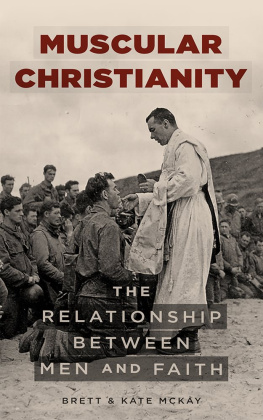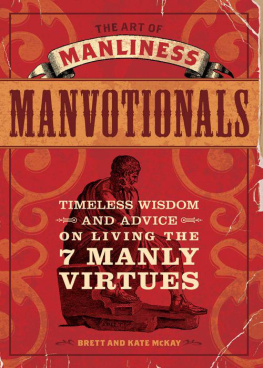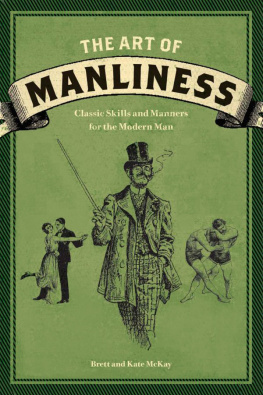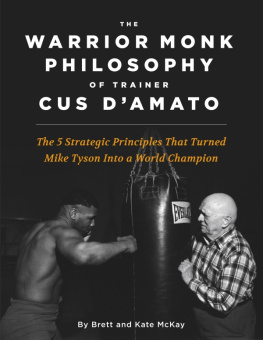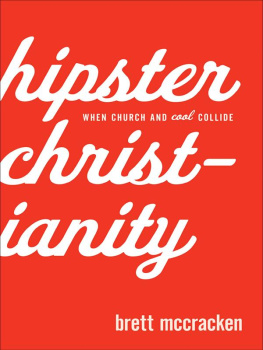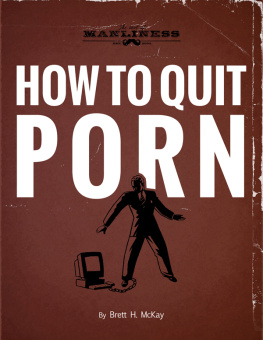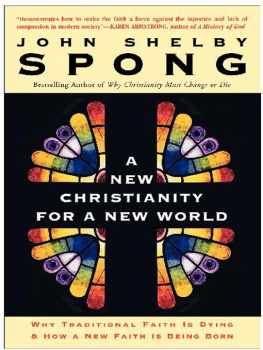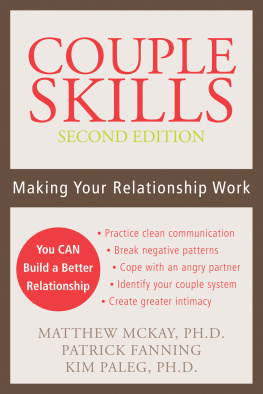Brett McKay - Muscular Christianity: The Relationship Between Men and Faith
Here you can read online Brett McKay - Muscular Christianity: The Relationship Between Men and Faith full text of the book (entire story) in english for free. Download pdf and epub, get meaning, cover and reviews about this ebook. year: 2018, publisher: BookBaby, genre: Religion. Description of the work, (preface) as well as reviews are available. Best literature library LitArk.com created for fans of good reading and offers a wide selection of genres:
Romance novel
Science fiction
Adventure
Detective
Science
History
Home and family
Prose
Art
Politics
Computer
Non-fiction
Religion
Business
Children
Humor
Choose a favorite category and find really read worthwhile books. Enjoy immersion in the world of imagination, feel the emotions of the characters or learn something new for yourself, make an fascinating discovery.
- Book:Muscular Christianity: The Relationship Between Men and Faith
- Author:
- Publisher:BookBaby
- Genre:
- Year:2018
- Rating:5 / 5
- Favourites:Add to favourites
- Your mark:
- 100
- 1
- 2
- 3
- 4
- 5
Muscular Christianity: The Relationship Between Men and Faith: summary, description and annotation
We offer to read an annotation, description, summary or preface (depends on what the author of the book "Muscular Christianity: The Relationship Between Men and Faith" wrote himself). If you haven't found the necessary information about the book — write in the comments, we will try to find it.
Muscular Christianity: The Relationship Between Men and Faith — read online for free the complete book (whole text) full work
Below is the text of the book, divided by pages. System saving the place of the last page read, allows you to conveniently read the book "Muscular Christianity: The Relationship Between Men and Faith" online for free, without having to search again every time where you left off. Put a bookmark, and you can go to the page where you finished reading at any time.
Font size:
Interval:
Bookmark:


Introduction
Attend a Christian church service anywhere in the world this Sunday and take a look around at whos sitting in the seats .
What will you see?
Almost certainly, more women than men. Women with husbands and families, but also married women attending without their husbands, widowed women, and single women, both young and old. You likely wont see any husbands who are attending without their wives, or very many single guys .
Among the men who are in attendance, youll probably notice a couple of characteristics: First, many of the men who are there will be present in body only; you wont see them singing and theyll be paying more attention to their phones than the pastor. Second, youll observe that the majority of the males adhere to a certain type: white collar, sensitive-seeming, and unfit (either very thin or overweight) fellows youd categorize as nice guys. Youll see only a few men who seem to work with their hands, or who youd describe as athletic, virile, earthy, tough, or rugged.
Pew Research has found that, on average, Christian congregants across the world skew about 53% female, 46% male. In the U.S., surveys show a split thats even wider: 61% women to 39% men (the gap occurs in every age category, and is thus not due to the fact that women live longer than men). In sheer numbers, what this means is that on any given Sunday in America, there are 13 million more women than men attending church.
In a few Christian churches, the ratio of women to men is close to equal; in others its a yawning 10 to 1. The gender disparity is greater in smaller, older, rural, and more liberal mainline churches, and lesser in larger, urban, more conservative, and non-denominational churches, but it shows up in every country, amongst Protestants and Catholics alike, and bypasses no denomination (with the possible exception of Eastern and Greek Orthodox); only 2% of Christian congregations in the U.S. do not have a gender gap.
Men are not only less likely to attend church, they are also less likely to participate in their faith in other ways. According to Pew Research, Christian women are 7% more likely than men to say religion is important to them. And as David Murrow records in his book, Why Men Hate Going to Church , research conducted by George Barna found that women are far more likely to be involved with their church and faith on nearly every level, to the tune of:
57 percent more likely to participate in adult Sunday school
56 percent more likely to hold a leadership position at a church (not including the role of pastor )
54 percent more likely to participate in a small group
46 percent more likely to disciple others
39 percent more likely to have a devotional time or quiet time
33 percent more likely to volunteer for a church
29 percent more likely to read the Bible
29 percent more likely to share faith with others
23 percent more likely to donate to a church
16 percent more likely to pray
Barna summed up his findings thusly: Women are the backbone of the Christian congregations in America.
So what accounts for this disparity between mens and womens commitment to the Christian faith?
You may be tempted to chalk it up to the fact that women are just generally more religious than men. Which is true. Across all religions and around the world, women are 13% more likely than men to say that religion is very important in their lives. Several theories, from the biological to the cultural, have been forwarded by researchers to explain this gap, and among the masses, plenty of armchair analysts posit that women are simply more inherently moral or spiritual than men.
Yet womens greater religiosity across all faiths doesnt at all explain the gender gap within Christianity itself. For as it turns out, its the only major world religion with a significant gender disparity among its adherents. Women are only more religiously inclined when surveys of Christians are averaged with those of Hinduism, Buddhism, Orthodox Judaism, and Islam faiths in which the religious commitment of their male and female members is close to equal.
For example, according to the Pew Research Center, while Christian men participate to a lesser extent in every area of their faith, the commitment of Muslim men and women to their religion is nearly identical, except in one facet Muslim men are a third more likely to attend services than women. Muslim men and women pray at almost exactly the same rate, and are just as likely to say their religion is important to them.
So it isnt true that men are less interested than women in all religions theyre just especially indifferent to the Christian faith.
Again, we return to the question: Why ?
Why does a religion started by a carpenter and his twelve male comrades attract more women than men? Christian churches are led predominately by men (95% of Protestant senior pastors and 100% of Catholic clergy are male) and are criticized by feminists as bastions of male patriarchy, power, and privilege; so why is the laity paradoxically composed largely of women ?
Was there ever a time when the gender ratio of Christianity was equal? And if so, why did a disparity between male and female adherents develop?
Among men who are committed Christians, why do they seem to be more effeminate, on average, than the male population as a whole? As Murrow puts it, what is it about Christianity, especially Western Christianity, that drives a wedge between the church and men who want to be masculine?
These are fascinating questions, certainly for Christians who have noticed this phenomenon themselves and for pastors of churches who are concerned about the health of their congregations (as well see, theres a strong connection between the number of men in a churchs pews and its vitality).
But its also a fascinating subject for anyone interested in the influence of economics and sociology on religion, and who understand the enormous influence religion has had and continues to have on Western culture in general, and conceptions of manhood in particular.
So over the course of this short book, well be exploring possible answers to the above questions. First, well outline various theories as to how, when, and why Christianity became feminized and unattractive to many men. Well then delve into the history of a time in which there emerged a dedicated response and effort to revive the masculinity of the faith a movement that went by the name of Muscular Christianity.
Chapter 1: Is Christianity an Inherently Feminine Religion?
In the introduction, we laid out that the disparity between mens and womens participation in church is not rooted in the fact that females are simply more religious than males overall, as Christianity is the only major world religion where men are significantly less committed than women.
One of theories as to why this is, is that the gender gap naturally arises from a theology and ethos that was inherently feminine from the start that the issue is baked-in, so to speak. In this chapter well examine the basis of this assumption, as well as how Christianity could be thought of as primarily masculine.
The Code of Manhood & the Femininity of Christianity
As we have documented in numerous articles on artofmanliness.com, the traits and qualities that are considered manly have been consistent for thousands of years, and universal to cultures around the world. While a boy was born a male, he had to earn the title of man, and he did so by proving himself in tests of skill and self-control, developing his autonomy, self-reliance, and toughness, embracing risk, struggle, and conflict, and competing with his peers to earn status. Physical strength was valued, along with other martial virtues like courage; battlefield prowess has always been central to the code of masculinity. Overall, a male had to excel in the 3 Ps of Manhood Protection, Provision, and Procreation in order to be considered a real man.
Font size:
Interval:
Bookmark:
Similar books «Muscular Christianity: The Relationship Between Men and Faith»
Look at similar books to Muscular Christianity: The Relationship Between Men and Faith. We have selected literature similar in name and meaning in the hope of providing readers with more options to find new, interesting, not yet read works.
Discussion, reviews of the book Muscular Christianity: The Relationship Between Men and Faith and just readers' own opinions. Leave your comments, write what you think about the work, its meaning or the main characters. Specify what exactly you liked and what you didn't like, and why you think so.

